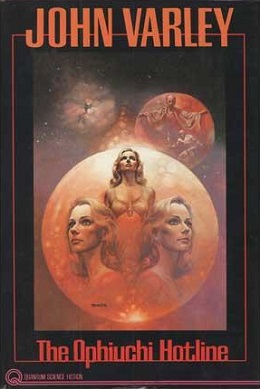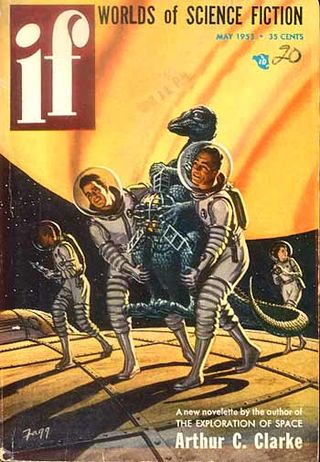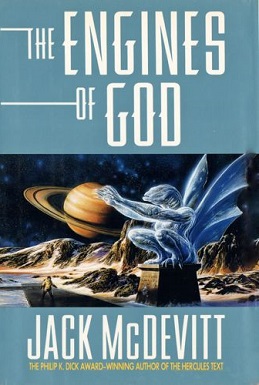Related Research Articles
Known Space is the fictional setting of about a dozen science fiction novels and several collections of short stories by American writer Larry Niven. It has also become a shared universe in the spin-off Man-Kzin Wars anthologies. The Internet Speculative Fiction Database (ISFDB) catalogs all works set in the fictional universe that includes Known Space under the series name Tales of Known Space, which was the title of a 1975 collection of Niven's short stories. The first-published work in the series, which was Niven's first published piece, was "The Coldest Place", in the December 1964 issue of If magazine, edited by Frederik Pohl. This was the first-published work in the 1975 collection.

Footfall is a 1985 science fiction novel by American writers Larry Niven and Jerry Pournelle. The book depicts the arrival of members of an alien species called the Fithp that have traveled to the Solar System from Alpha Centauri in a large spacecraft driven by a Bussard ramjet. Their intent is conquest of the planet Earth.

Code of the Lifemaker is a 1983 novel by British science fiction author James P. Hogan. NASA's report Advanced Automation for Space Missions was the direct inspiration for this novel detailing first contact between Earth explorers and the Taloids, clanking replicators who have colonized Saturn's moon Titan.

Protector is a 1973 science fiction novel by American writer Larry Niven, set in his Known Space universe. It was nominated for the Hugo in 1974, and placed fourth in the annual Locus poll for that year.

The Ophiuchi Hotline is a 1977 science fiction novel by American writer John Varley. It was nominated for a Locus Award. Part of his Eight Worlds series, the novel opens in the year 2618.

The Collected Short Fiction of C. J. Cherryh is a collection of science fiction and fantasy short stories, novelettes and novella written by American author C. J. Cherryh between 1977 and 2004. It was first published by DAW Books in 2004. This collection includes the contents of two previous Cherryh collections, Sunfall (1981) and Visible Light (1986), all of the stories from Glass and Amber (1987), stories originally published in other collections and magazines, and one story written specifically for this collection ("MasKs"). Cherryh's 1978 Hugo Award winning story, "Cassandra" is also included.

Saturn has made appearances in fiction since the 1752 novel Micromégas by Voltaire. In the earliest depictions, it was portrayed as having a solid surface rather than its actual gaseous composition. In many of these works, the planet is inhabited by aliens that are usually portrayed as being more advanced than humans. In modern science fiction, the Saturnian atmosphere sometimes hosts floating settlements. The planet is occasionally visited by humans and its rings are sometimes mined for resources.
Michael W. Carroll is an astronomical artist and science writer. His art has appeared in magazines such as TIME, National Geographic, and Astronomy, and has flown aboard the Russian space station Mir and NASA's Phoenix Mars lander. He is also a founding member of the International Association of Astronomical Artists.

Imperial Moon is a BBC Books original novel written by Christopher Bulis and based on the long-running British science fiction television series Doctor Who. It features the Fifth Doctor, Turlough, and Kamelion.
Space Museum was a science fiction comics series published by National Comics in their flagship science fiction title Strange Adventures between 1959 and 1964. The series was written by Gardner Fox and was drawn by Carmine Infantino for almost the whole series.

"Jupiter Five" is a science fiction short story by British writer Arthur C. Clarke, first published in the magazine If in 1953. It appeared again in Clarke's collection of short stories Reach for Tomorrow, in 1956, and deals with the detection and exploration of an old spaceship from outside the Solar System.

Ancient astronauts have been addressed frequently in science fiction and horror fiction. Occurrences in the genres include:
The Little Green Man is an animated cartoon series about a boy called Sydney Keets, nicknamed "Skeets", who befriends the inquisitive, friendly alien Little Green Man, nicknamed "Greenie", when his spaceship lands in Skeets' garden. Bar a few minor instances, such as the family cat, Skeets is the only character able to see Greenie, and along with Greenie's small friend Zoom Zoom, they share a series of fantastical adventures together, each serving to educate Greenie about life on Earth in some way or another.

Leviathan Wakes is a science fiction novel by James S. A. Corey, the pen name of American writers Daniel Abraham and Ty Franck. It is the first book in the Expanse series, followed by Caliban's War (2012), Abaddon's Gate (2013) and six other novels. Leviathan Wakes was nominated for the 2012 Hugo Award for Best Novel and the 2012 Locus Award for Best Science Fiction Novel. The novel was adapted for television in 2015 as the first season-and-a-half of The Expanse by Syfy. Five short stories that take place before, during, or after Leviathan Wakes were published between 2011 and 2019.

Caliban's War is a 2012 science fiction novel by James S. A. Corey. It is about a conflict in the Solar System that involves the polities Earth, Mars, the Asteroid Belt and the outer planets, and a powerful extraterrestrial biological von Neumann probe. The second book in The Expanse series, it was preceded by Leviathan Wakes. The third book, Abaddon's Gate, was released on June 4, 2013. One of eight short stories and novellas published by James S. A. Corey, entitled "Gods of Risk", takes place directly after the events of Caliban's War.

The Engines of God is a science fiction novel by American author Jack McDevitt.

The Day the Earth Smiled is a composite photograph taken by the NASA spacecraft Cassini on July 19, 2013. During an eclipse of the Sun, the spacecraft turned to image Saturn and most of its visible ring system, as well as Earth and the Moon as distant pale dots. The spacecraft had twice taken similar photographs in its previous nine years in orbit around the planet. The name also refers to the activities associated with the event, as well as to the photographic mosaic created from it.

The Secret of the Ninth Planet is a science-fiction novel written by Donald A. Wollheim and first published in the United States in 1959 by the John C. Winston Co. Wollheim takes his heroes on a grand tour of the Solar System as that team struggles to prevent an alien force from blowing up the Sun. This is the last of three juvenile novels that Wollheim wrote for Winston, the other two being The Secret of Saturn's Rings and The Secret of the Martian Moons.
A list of works by, or about, the American science fiction author Larry Niven.

Overload is a 3D first-person shooter video game developed and released by Revival Productions for Windows, macOS and Linux on May 31, 2018. A version for PlayStation 4 was released on October 16. It features six degrees of freedom movement in a 3D environment with zero gravity, allowing the player to move and rotate in any direction. The game is set primarily on the moons of Saturn, where facilities have sent out distress signals about the mining robots turning hostile.
References
- ↑ Bob Ketelle (February 18, 2010). "'Saturnalia' an old but good space tale". Las Vegas Review-Journal.
- ↑ "Locus Awards 1986". Science Fiction Awards Database.